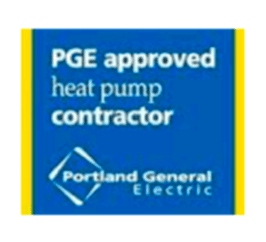Keeping your home warm and cozy during Portland’s chilly winter months is essential, but setting your thermostat too high could lead to skyrocketing energy bills. Striking the right balance between comfort and efficiency doesn’t just save money—it can also improve your home’s energy usage and reduce strain on your heating system. The bonus of setting your thermostat to an ideal-for-your-home temperature is that you can tame the thermostat wars by finding ways to keep everyone comfortable.
Factors Determining the Ideal Temperature
Finding the best temperature for your heater in winter depends on several factors, including comfort, energy efficiency, and humidity. Understanding these elements can help you set a thermostat level that works for your household.
1. Energy Efficiency
The U.S. Department of Energy recommends setting your home’s thermostat to 68°F during the day when people are home and lowering it by 7-10°F at night or when no one is home. This strategy can reduce energy bills by as much as 10 percent annually.
2. Comfort
While 68°F works for some, others may prefer it warmer. To find your ideal temperature, make small adjustments and layer up instead of cranking the heat. A helpful trick is to cover the thermostat display for a week, focusing on comfort rather than the number. Keep in mind that thermostats, especially minisplit/ductless systems, can be slightly inaccurate.
3. Humidity Control
When your home is adequately heated, it should maintain a healthy humidity level of about 30-50%. Too much heat can dry out the air, making your home uncomfortable and causing issues like dry skin or respiratory irritation. A balanced temperature helps maintain indoor air quality and comfort.
What is a Degree and Why It Matters?
A degree on your thermostat represents a unit of temperature measurement, typically in Fahrenheit or Celsius, that determines how warm or cool your home will feel. While it may seem like raising your thermostat by just one or two degrees is a small adjustment, the impact on your home’s comfort and energy usage can be significant.
Each degree increase requires your heating system to work harder to maintain the new target temperature, leading to higher energy consumption. Additionally, even a slight change in temperature can affect the overall comfort level in your home, as the air might feel noticeably warmer or lead to overheating for some individuals. That’s why finding and maintaining an optimal temperature for your family is an important step for achieving both comfort and efficiency.
How Portland’s Climate Influences Heating Needs
Portland’s winter temperatures often hover between 35°F and 45°F, with frequent rainfall adding an extra layer of chill. This mild but wet climate means you don’t need to set your heater as high as someone living in harsher winter conditions might.
The key is to adapt based on the day’s weather trends. On damp, rainy days, the perceived temperature may feel colder even if the thermostat says otherwise. Layers, blankets, and strategic thermostat tweaks can ensure your home stays cozy without excessive energy consumption.
Thermostat Basics
Let’s go over the different types of thermostats. Here are the three main types:
Manual Thermostats
Manual thermostats are the most straightforward option. They require you to adjust the temperature settings manually, making them a cost-effective solution for those on a budget. While simple to use, they lack advanced features and can result in uneven heating or cooling if adjustments aren’t made regularly.
Programmable Thermostats
Programmable thermostats allow you to schedule temperature settings based on your daily routines. You can set them to lower the temperature at night or when you’re not home and raise it before you wake up or return. This automation helps reduce energy consumption and improves efficiency, making them a popular choice for homeowners seeking convenience and savings.
Smart Thermostats
Smart thermostats take convenience to the next level by connecting to Wi-Fi and allowing control via smartphone apps or even voice commands. Many models learn your preferences over time and adjust automatically to suit your habits. They can provide energy use insights and help optimize efficiency by adapting to weather conditions, making them ideal for tech-savvy individuals prioritizing comfort and energy savings.
Choosing the right thermostat depends on your lifestyle, energy goals, and budget. Each type offers unique advantages to help you maintain a comfortable, energy-efficient home.
How Programmable Thermostats Can Help
1. Optimize Your Comfort and Savings
Programmable and smart thermostats have revolutionized home heating by offering customized schedules and precise temperature control. For example, you can program your thermostat to heat the house to 68°F when you wake up, drop a few degrees while you’re away at work, and return to a comfortable temperature by the time you’re home.
2. Navigate Thermostat Wars
Thermostat disagreements in households are common (“Why is it always so cold in here?!”). By using programmable settings, every family member can reach a compromise by planning ahead—68°F can stay standard during the day, while higher or lower evening temperatures are adjusted based on who controls the remote later.
Installing a Smart Thermostat
Upgrading to a smart thermostat can enhance energy efficiency and provide you with greater control over your home’s temperature. Before installation, ensure compatibility with your HVAC system:
- Check Compatibility: Refer to your thermostat and HVAC system’s manuals or consult the manufacturer’s website.
- Look for a C-Wire: Most smart thermostats require a common wire (C-wire) for power.
- Seek Professional Help: If unsure, hire a licensed Jacobs HVAC technician for installation and guidance.
Tips for Balancing Warmth and Savings
Ensuring your home is warm and inviting without wasting energy requires a mix of small adjustments and long-term improvements.
1. Dress in Layers Indoors
Throw on a sweater, fuzzy socks, and warm slippers to stay cozy without needing to adjust the thermostat by more than a degree or two.
2. Use Zone Heating
If you only use specific rooms during the day, consider installing zoned ductless heat pump system. This minimizes energy waste—and your utility costs.
3. Leverage Natural Light
During Portland’s rare sunny winter days, open the blinds and curtains to allow natural light to warm your home. Bonus tip: Close them at night to trap in the heat.
Improving Home Insulation
Your heater can only work so hard before thermal losses sabotage its efforts. By improving your home’s insulation, you can help maintain a consistent indoor temperature while reducing energy consumption.
1. Upgrade Windows and Doors
Windows and doors are the primary culprits when it comes to escaping heat in most homes. Consider updating them with more energy-efficient models.
2. Add Insulation to Walls, Attic, Floors
If you live in an older home, chances are your insulation is lacking (or nonexistent). Adding insulation to your walls, attic, and floors can help keep your home warm without needing to crank up the thermostat. Plus, it’s a cost-effective way to increase your home’s value.
Home Comfort with Portland’s HVAC Specialists
Smart thermostats are an excellent long-term solution for enhancing both convenience and reducing your annual energy costs. With features like pattern recognition and remote control capabilities, they make it easy to optimize your heating and cooling preferences from anywhere. Plus, they can significantly reduce the thermostat wars within your home.
If you’re considering installing a smart thermostat in your Portland home, reach out to Jacobs Heating and Air Conditioning to speak with a Home Automation specialist about our range of smart thermostat options. Whatever your HVAC needs, we are here to help.










